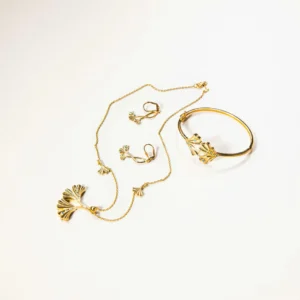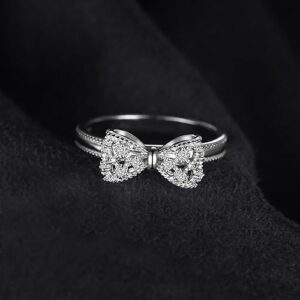Gold has always been more than just a shiny metal—it’s a symbol of wealth, love, and timeless beauty. From ancient kings to modern couples, this precious metal carries stories and memories that make it priceless.
But here’s the catch: not all gold is the same.
This guide breaks down the different types of gold in a way that’s simple. By the end, you’ll not only recognize the differences but also know which type of gold is best for your style, budget, and lifestyle needs.
Table of Contents
What Does "Types of Gold" Mean?
Walk into any jewelry store and you’ll hear terms like 24K, 18K, white gold, rose gold, gold-plated, or solid gold. If you’re new to jewelry, all of this can feel overwhelming.
So, let’s clear up a common misunderstanding. When people talk about the “types of gold,” there are countless ways jewelers can classify it. However, most variations usually fall into three main categories:
- Gold Purity (karat system)
- Gold Colors (shades created through alloys)
- Gold Formation (the way gold is crafted for jewelry)
So why does this matter? Because these factors directly affect the price, durability, appearance, and lifespan of your jewelry.

Understanding Gold Purity (Karat System)
The term karat (K) shows how much pure gold is in a piece. 24K is 99.9% pure gold but it’s too soft to be used alone in most jewelry, while 18K, 14K, and 10K are mixed with metals like like copper, silver, nickel, or palladium to make them stronger.
The rule is simple:
- Higher karat = more pure gold, softer, and pricier.
- Lower karats are less pure but more durable—perfect for everyday wear.
Gold purity also affects how it reacts with your skin. Higher karat gold (22K–24K) rarely causes allergies, while lower karats (10K–14K) may irritate sensitive skin due to their higher content of base metals.
Let's Discuss Different Gold Karats

24K Gold: Pure Luxury
24K gold is 99.9% pure gold, known for its rich yellow color and unmatched shine. It’s considered the ultimate symbol of wealth and prestige. However, because pure gold is soft, it’s not practical for everyday wear and is mostly seen in coins, bars, and luxury jewelry.
22K Gold: Traditional Elegance
Made of about 91.6% gold and 8.4% alloys (small amounts of silver or copper). It’s a favorite in traditional jewelry markets like India and the Middle East, especially for wedding pieces and family heirlooms. While stronger than 24K, it can still bend with heavy wear.
18K Gold: The Perfect Balance
Containing 75% gold and 25% alloys, 18K is considered the ideal balance of beauty and durability. Its rich golden hue and strength make it perfect for engagement rings, wedding bands, and luxury watches. Many high-end brands like Cartier and Tiffany use 18K for fine jewelry.
14K Gold: America’s Favorite Choice
With 58.3% purity, 14K gold is the most popular choice in the U.S.. Strong, affordable, and scratch-resistant, it’s ideal for daily wear jewelry like rings, chains, and bracelets. Its color is slightly lighter than 18K but still retains a classic golden look.
10K Gold: Budget-Friendly Durability
At 41.7% purity, 10K is the minimum standard for fine jewelry in the U.S.. It’s the most durable and budget-friendly option, though paler in color and lower in resale value. Perfect for fashion jewelry, men’s rings, and kids’ jewelry, where strength matters more than purity.
| Karat | Gold % | Durability | Price Range | Best Use in Jewelry |
|---|---|---|---|---|
| 24K | 99.9% | Very Soft, scratches easily | Highest | Collectors’ pieces, luxury investment jewelry |
| 22K | 91.6% | Softer, needs care | Very High | Traditional jewelry, wedding sets in Asia/Middle East |
| 18K | 75% | Good balance of strength & purity | High | Engagement rings, fine jewelry |
| 14K | 58.3% | Strong & durable | Moderate | Everyday wear, most popular in US |
| 10K | 41.7% | Extremely durable, less gold content | Budget-friendly | Affordable jewelry, sturdy designs |
Exploring Gold Colors: Yellow, White, Rose and More
Gold jewelry is no longer limited to its classic yellow shine. By mixing pure gold with alloys, jewelers create stunning gold colors like white gold, rose gold, and even unique shades such as green or black—each offering its own style, meaning, and fashion appeal.

Yellow Gold: The Timeless Classic
Yellow gold is the most traditional form of gold, valued for its warm, rich glow. Since pure 24K is too soft, it’s mixed with alloys like copper and silver for strength. Higher karats (18K–22K) show a deeper golden hue, while lower ones (10K–14K) are more durable, making yellow gold suitable for both daily wear and special occasions.
White Gold: Modern Sophistication
White gold is made by blending pure gold with metals like palladium, nickel, or silver, and finished with rhodium plating for a platinum-like shine. It’s durable and elegant, often used in engagement rings. Over time, rhodium wears off and requires replating, but white gold remains a popular modern choice.
Rose Gold: Romantic and Trendy
Rose gold’s pink hue comes from mixing gold with copper. The more copper, the deeper the shade. It’s stronger than yellow or white gold and doesn’t need plating. Loved for its romantic and vintage appeal, it suits all skin tones—though those sensitive to copper should take care.
Green Gold: Nature's Inspiration
Green Gold also called electrum, created by mixing gold with silver (sometimes with a little cadmium in old methods). The silver lightens the yellow tone, giving a fresh greenish hue, It also tends to be hypoallergenic because of the silver content, but in some alloys, nickel may be added, which can cause allergic reactions for sensitive skin.
Few mention these colors, but Jewelers are now experimenting with “black gold” (achieved through surface treatments like ruthenium plating) and blue/purple gold (made using aluminum or indium alloys). These experimental colors are fragile but are making appearances in luxury designer collections.
| Gold Color | Compositions | Durability | Appearance | Best Use/ Notes |
|---|---|---|---|---|
| Yellow Gold | Gold + copper & silver | Medium | Warm, rich golden glow | Classic choice; higher karats deeper hue; suitable for daily wear and special occasions |
| White Gold | Gold + palladium, nickel, or silver; rhodium-plated | Medium-High | Platinum-like shiny white | Popular for engagement rings; rhodium plating may require replating over time |
| Rose Gold | Gold + copper | High | Pink to deep rose hue | Romantic, vintage appeal; suits all skin tones; no plating required |
| Green Gold (Electrum) | Gold + silver (sometimes cadmium) | Medium | Soft greenish-yellow | Hypoallergenic; some alloys may include nickel, check for sensitivity |
| Black Gold | Surface treatments like ruthenium plating | Low-Medium | Dark black metallic | Fragile; mostly used in luxury designer collections |
| Blue Gold | Gold + iron or indium (heat-treated) | Low | Metallic blue | Rare and fragile; mainly used in designer or luxury jewelry |
| Purple Gold (Amethyst Gold) | Gold + aluminum (forms AuAl₂ intermetallic compound) | Very Low / Brittle | Purple metallic | Very brittle; suitable for inlays, pendants, or decorative pieces, not daily wear |
Types of Gold by Form for Jewelry
When buying gold jewelry, it’s important to understand how the gold is formed and applied to the piece. The form of gold determines not only its value but also its durability, longevity, and price point. Here are the main types of gold by form:

Solid Gold: The Investment Standard
Solid gold jewelry is made entirely from gold alloy, not hollow or plated, making it highly durable and valuable. Available in 10K, 14K, 18K, and 22K, it never tarnishes, retains color, and can be resized or repaired. Ideal for wedding bands, engagement rings, and heirloom jewelry, solid gold offers both beauty and resale value.
Gold-Filled Jewelry: The Smart Alternative
Gold-filled jewelry bonds a thick layer of 12K or 14K gold to a base metal like brass. By law, gold must make up at least 5% of the piece’s weight, making it much longer-lasting than plating. With care, it can last 10–30 years, polish well, and is perfect for daily wear at a lower price than solid gold.
Gold Vermeil: Sterling Silver’s Luxury Upgrade
Gold vermeil is sterling silver coated with a thick gold layer (minimum 2.5 microns, 14K or higher). More durable and hypoallergenic than standard plating, it offers a luxury look at an affordable cost. Best for those with sensitive skin or seeking stylish, budget-friendly jewelry without heavy daily use.
Gold-Plated Jewelry: The Budget-Friendly Option
Gold-plated jewelry uses a very thin layer of gold (under 1 micron) over base metal. It’s the cheapest way to get the look of gold, ideal for fashion jewelry and trends. However, plating wears off within months–2 years and cannot be repaired. Not suitable for sensitive skin due to exposure of the base metal.
| Gold Form | Composition / Layers | Durability | Price Range |
|---|---|---|---|
| Solid Gold | 100% gold alloy (10K–22K) | Very High | High |
| Gold-Filled | Thick layer of 12K–14K gold bonded to base metal (≥5% gold by weight) | High | Medium |
| Gold Vermeil | Sterling silver coated with thick gold layer (≥2.5 microns, 14K+) | Medium-High | Medium |
| Gold-Plated | Very thin gold layer (<1 micron) over base metal | Low | Low |
Frequently Asked Questions
If the ring will be worn daily, 14K white gold is the most practical—durable, elegant, and resistant to scratches. Yellow gold gives a timeless, classic look, while rose gold feels romantic and modern. Higher karats like 18K–22K have a richer color but are softer and may need more care.
Go for 10K or 14K gold. These blends are stronger because of their alloy content, making them perfect for daily wear. They resist scratches better than high-karat gold, yet still look beautiful.
For pure value, choose 22K or 24K solid gold in coins, bars, or bangles. While these are too soft for everyday wear, they hold the highest resale and intrinsic value, making them ideal for wealth storage.
Some white gold alloys contain nickel, which may cause irritation. If that’s a concern, pick palladium-based white gold, 18K–22K yellow gold, or even platinum for an allergy-free, luxurious option.
Pure gold (24K) does not tarnish. However, lower-karat gold (such as 10K, 14K, or 18K) may tarnish slightly over time because of the alloy metals mixed in, like copper or silver. Regular cleaning keeps it looking shiny.
Look for hallmarks or stamps (e.g., 10K, 14K, 18K, 22K, 24K, or 925 for gold vermeil). You can also test with a magnet (real gold isn’t magnetic) or visit a jeweler for an acid test or XRF scan.
Final Words: Choosing the Right Type of Gold
Knowing the types of gold helps you pick jewelry that matches your budget, style, and lifestyle. Yellow gold has a timeless charm, white gold gives a modern touch, while rose gold adds a romantic glow.
Gold also comes in different purities, colors, and forms, each affecting its durability and value. For instance, a 14K rose gold ring lasts differently than an 18K yellow gold piece or a gold-filled design.
Before buying, ask yourself:
- Do you want purity and long-term value? Go for 18K–24K solid gold.
- Do you need everyday durability? Choose 10K–14K gold.
- Shopping on a budget? Try gold-filled or vermeil jewelry.
With these tips, you can confidently compare gold types and invest in jewelry that stays beautiful for years.



